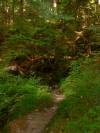


Washington State...July 2002
Just click on the pictures to enlarge photo's.
 |
 |
 |
 |
 |
 |
 |
| Hayes River Ranger Station | Ferns and Moss | Fallen Tree | Moss carpet | Ferns and Moss | Steep Trail | Strange Fungus |
Emergency gear -
Tips to help you in primitive camping situations
Waterproof matches in airtight containers, metal matches, fire starter and ‘tinder' are suggested. Extra food and clothing, a signal mirror, smoke flare, durable space blankets, plastic bags, and a good first aid kit are extremely valuable if you plan on being out for several days. Cord can be used to make a shelter and hang food in trees. Most hikers carry water purification filters or chemicals. Some even carry pocket strobe lights, and a few carry personal locator beacons. Plan to be self sufficient in any emergency. The land is vast and remote, and you cannot count on early help if you have difficulties.
Equipment -
Try and keep your gear lightweight yet durable. Equipment should withstand rigorous use in a rough, mountainous countryside. Help could be many hours away should something go wrong with your gear.
Food and Supplies -
Bring your food, equipment and other supplies with you. Avoid food such as bacon or smoked fish, soaps, and cosmetics with strong odors as they attract bears. Bottles and cans are hard to dispose of. If you take them in, you are expected to carry them out. Without some sort of bear proof storage, you should be prepared to hang your food as high as possible. Federal Aviation Administration regulations prohibit carrying fuel in containers such as stoves on commercial airlines. Use white gas.
Footwear -
Boots should be a sturdy hiking or mountaineering type that provides good ankle support. Some hikers prefer boots with the rubber shoe and leather upper, like the Maine Hunting Shoe. You can count on your feet getting wet regardless of your boot type, so durability and support should be a prime concern. Many pair of socks are essential. Tennis shoes are good for crossing rivers.
Insects -
Insect repellent and head nets are highly recommended.
Map -
Trails Illustrated topo map covers the whole park and includes the most current information on the location of trails and camps. Green Trails maps contain more topographic information and include trail mileage. USGS maps provide the most detailed topographic information. Although campsite and trail information are often outdated, these are the preferred maps for mountaineering and cross-country travel. Maps, books and pamphlets are sold at park headquarters and ranger and information stations.
Rain Gear and Clothing -
Durable rain gear that covers both the upper and lower torso is a must for hikes of any length. The rain gear should keep out water in a steady down pour. Since you will eventually get wet in any significant rain storm, wool or synthetic clothing that insulates when wet is highly recommended for wear under rain gear. The weather can change quickly and without warning. Expect rain and drizzle. Hypothermia is always a possibility with wet conditions and cool temperatures.
Stove -
A gasoline stove is essential. You may not cut down live trees. Set campfires with downed wood only.
Tents and Sleeping Bags -
You should have a tent with a waterproof floor, rain-fly, and a no-see- um netting, and this tent should be designed to withstand strong winds. Bring plenty of extra stakes and strong cord to keep the tent secure. Synthetics like ‘Polarguard' or ‘Fiberfill' are better than down in a wet environment because synthetics will insulate when wet while down will not. A sleeping pad will provide insulation as well as comfort.